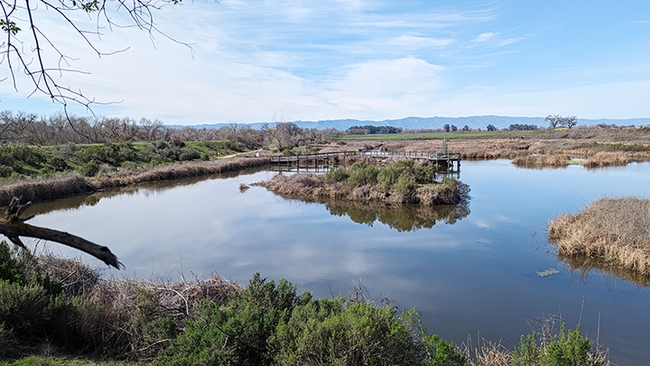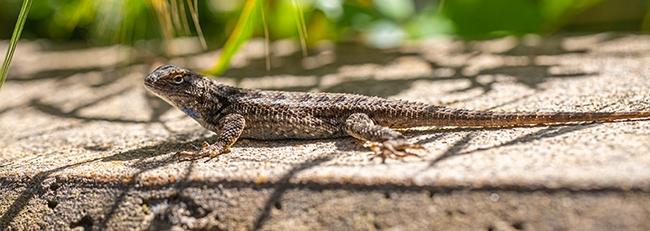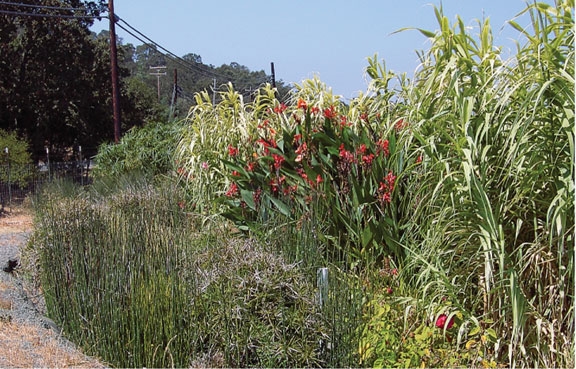
Posts Tagged: wetlands
Of Tules, Cattails and Dragonflies...and on St. Pat's Day!
Medical entomologist-geneticist Geoffrey Attardo, associate professor, UC Davis Department of Entomology and Nematology (ENT), is excited to organize a wetland symposium, set Sunday, March 17 from 1 to 5 p.m. in the UC Davis Conference Center, located on campus at 550 Alumni...

This is the wetland area in Cache Creek conservatory which is adjacent to the Tending and Gathering Garden. (Photo by Geoffrey Attardo)

The flameskimmer dragonfly, Libellula saturata, commonly perches on a tule stalk. (Photo by Geoffrey Attardo)

A lizard sunning in the tules. (Photo by Geoffrey Attardo)
Wildlife, wetlands, water to be discussed at rangelands summit Jan. 21-22

The Fogarty family has been in the cattle ranching business in Stanislaus County since the 1870s. In recent years, they’ve seen rangeland around them converted to housing and orchards. “With the conversion around us, we are affected with a declining water table, increased traffic and rural crime associated with high production agriculture,” said Bill Fogarty.
Ranchers, researchers, managers, agency representatives and conservationists will gather in January to discuss challenges and opportunities in maintaining rangelands.
Keeping rangelands and ranches viable for wildlife, wetlands and water will be discussed at the 9th annual California Rangeland Conservation Coalition Summit set for Jan. 21-22 at the Gene Bianchi Community Center in Oakdale, 16 miles northeast of Modesto. The summit is sponsored by the California Rangeland Conservation Coalition and the University of California Cooperative Extension.
“This event is a time for ranchers to showcase their positive role in stewarding California’s wide open spaces and their contributions to the state’s economy,” said Tim Koopmann, president of the California Cattlemen’s Association. “Ranchers who attend the annual event learn valuable information on the latest research outcomes about best management practices for their land that simultaneously improve the natural resources and economic profitability.”
At risk is the future of California’s ranching industry and the ecosystem services that ranches provide: diverse wildlife, unique wetlands and healthy watersheds. At the rangeland summit, ranchers, researchers, land managers, agency representatives and conservationists will focus on rangeland science, land management, land-use policy and livestock production.
The event will feature presentations on the challenges ranchers face, impacts of rangeland conversion to natural resources and opportunities to support working ranches and rancher stewardship. Ranchers from Colorado and Montana will share new opportunities they are finding to keep ranching viable through conservation efforts.
The first day of the two-day summit will feature presentations and a ranch tour on the second day.
“University of California Cooperative Extension is pleased to be a partner in bringing together a diverse group of people interested in rangelands to discuss the opportunities and challenges for keeping California’s ranches working to support communities and habitat,” said Theresa Becchetti, UC Cooperative Extension advisor in San Joaquin and Stanislaus counties. “We are particularly fortunate to be able to hold this meeting and engage in a constructive dialogue with stakeholders in Oakdale, where rangelands and associated resources are at risk.”
This event is sponsored by University of California Agriculture and Natural Resources, Environmental Defense, Audubon California, California Association of Resource Conservation Districts, California Cattlemen’s Association, California Native Plant Society, California Rangeland Trust, Santa Clara County Open Space Authority, Center for Natural Lands Management, Defenders of Wildlife, Cal-Pac Chapter Society for Range Management, East Bay Regional Park District, Grazing Lands Conservation Initiative - California, Natural Resources Conservation Service, US Fish and Wildlife – Partners Program, Mid-Peninsula Open Space District, Point Blue Conservation, Sierra Business Council, Sierra Nevada Conservancy, Sustainable Conservation, InterWest Insurance Services, Inc., The Nature Conservancy, Koopmann Rangeland Consulting, and Westervelt Ecological Services. In addition, Oakdale Cowboy Museum and numerous private ranchers are sponsors, hosts and speakers.
The event is open to ranchers, researchers, land managers, agency representatives, conservationists and others interested in California’s rangelands. Journalists are encouraged to attend the event. For more information, visit http://www.carangeland.org/calendarevents/2014summit.html or call Pelayo Alvarez at (916) 313-5800, ext. 107.
###
The California Rangeland Conservation Coalition is a group of over 125 agricultural groups, nonprofit organizations, researchers and government agencies representing a broad cross-section of California’s ranching and environmental communities. The disparate groups are united by their recognition of the importance of California’s working rangelands for natural resources, plant and wildlife species, cultural values and economics. The Rangeland Coalition began in 2005 with a small group of organizations committed to protecting rangelands within California’s Central Valley and Interior Coast ranges. www.carangeland.org
Caltrans to cooperate with UCCE on long-term rangeland practices study
A settlement between Caltrans and the California Farm Bureau Federation, which resulted in CFBF dismissing a lawsuit against Caltrans about the Willits Bypass Project, includes a long-term wetlands study by UC Davis and UC Cooperative Extension researchers, according to Caltrans and farm bureau press releases issued last week.
Caltrans is building a bypass along U.S. Route 101 around the community of Willits. The project will relieve congestion, reduce delays, and improve safety for traffic and pedestrians, Caltrans said. CFBF filed the lawsuit because of concern about how the project would impact farmland in the Little Lake Valley.
"Specifically, Farm Bureau was concerned about the amount of farmland the U.S. Army Corps of Engineers mitigation strategy required to be removed from production in order to mitigate for wetlands affected by the bypass," the CFBF press release said.
According to the terms of the agreement noted in both press releases, Caltrans will cooperate with UC Davis and UCCE to study how grazing management contributes to enhanced wetland function.
The study will look at land owned by the state — where grazing is required — and federally owned land — where grazing is prohibited — and consider how to optimize grazing productivity while achieving the desired wetlands enhancements. The research will provide an opportunity to study how natural resources can be preserved and land utilized for both grazing and wetlands.

UC researchers will study how to optimize grazing productivity while achieving desired wetlands enhancements.
Biofilms: Friends or foes?
"Biofilms" surround us. They pervade our environment and our bodies. They form the dental plaque on our teeth and establish the chronic infections in our childrens' ear canals. They can spread on the watery surface of a contact lens.
Biofilms are now thought to be involved in 80 percent of human microbial infections, and are likely responsible for the resistance of chronic infections to antibiotics. Biofilms even form around "extremophiles" – such as the ancient blue-green cyanobacteria that thrive in extreme environments like the hot springs of Yellowstone National Park and the lake crusts of Antarctica. These microorganisms with fossil records going back 3.5 billion years also clog water pipes and create the slimy film on rocks in a pond.
A “biofilm” is a protective environment created by a microbial population. When microbes such as bacteria sense a “quorum” of their kind nearby, they begin to modify their genetic instructions to produce polysaccharides. The result is a sticky matrix that enables them to adhere to each other, and to surfaces.

But there is more to this story. Biofilms can also be employed for our benefit. Many sewage treatment plants include a stage where wastewater passes over biofilms, which “filter” — that is, extract and digest — organic compounds. Biofilms are integral to our current engineering processes for wastewater treatment.
Similarly, they play an essential role in constructed wetlands (CW), the artificial systems that approximate natural wetlands and that are used to treat wastewater or stormwater runoff. Most constructed wetlands are planted with hydrophilic (water loving) plants, while others are simply a gravel “filter” media. Both involve biofilms at the water-solid interfaces.
Recent research has now shown that planted CW systems — with their associated biofilms — are significantly more effective in the first weeks and months of treating agricultural processing wastewater.
In greenhouse trials, the planted system removed approximately 80 percent of organic-loading oxygen demand from sugarcane process wastewater after only three weeks of plant growth. The unplanted system removed about 30 percent less.
“Every constructed wetland system has a 'ripening period' during which the biofilm is forming," said Mark Grismer, UC Davis biological engineer. "Ripening means the time it takes for bacteria or other microorganisms to become established and functioning with respect to organics removal. Results indicate this ripening period is shorter in planted CW systems, and can be as short as three weeks if fast-growing aquatic plants are involved in the constructed wetland. In systems without plants, it can continue for two to three years.”

“Plant roots provide the structure needed for biofilm bacteria to process wastewater. Also, because the surface area of plant roots is far greater than that of the sand, gravel, or rock substrate alone, and because roots have the ability to partially oxygenate their surfaces, they can support thicker and perhaps more robust biofilms,” he said.
Studies like this one are providing the field data needed to strengthen efforts to clean up agricultural processing wastewaters.
To read the complete article, go to the April-June edition of California Agriculture journal.
